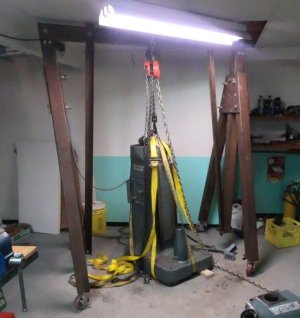I thought people would like to discuss gantry cranes and how they might be built, used, etc.There seems to be some interest in me describing the build of mine, so here goes:
I needed it to be versatile, from 7' tall overall, to doing an 11 foot lift. I knew that I'd be lifting stuff up to 2 tonnes, so I built it to carry at least twice that - this is common practice for rating lifting equipment.
My first design choice was to make the tubing size all 4". Right away I screwed up and bought steel for the legs with .250 wall. Way too heavy, after all I wasn't building a 50 ton crane! I re-purchased .166 wall which is still stronger than I needed...
Here's a photo in Bert's basement, with a 7' ceiling. Note it is using the short main beam for maneuverability and lower height. It is made from the 4" X.250 wall tubing discussed above.

The castors are 2800lb Casterland casters with rotational locks.
The legs are 6 foot long 4X4 .166 wall tubing.
The diagonal braces are 2X2X.125 angle iron
The risers the move up and down, and hold the main beam are 6 foot long 4X4X.188 wall tubing
Those trapezoidal plates are high tensile steel, waterjet cut .250 thick
This main beam is 6' long 4X4 .250 wall
The long main beam shown below is 4" X8" X.288 wall structural tubing X 10 feet 4 inches long
All fasteners are 3/4" diameter national coarse, except:
The plates connecting the main beam to the risers are 3/8 plate, with tow 5/8 fasteners per plate, 4 plates
Here's it is in use at my shop:

A few design notes: With the large beam it will safely lift 5 tonnes, so I overbuilt by a bit. With the small beam it will lift closer to 7 tonnes, because of the short span and thick main beam walls.
The build was mostly "drill holes", get plates from water jet, assemble. The only welding was for the plates the casters sit on, the casters will fail before the compression welds give out.
A quick word on the weight. It isn't light. the main beam measured 225 lbs. Each end assembled is over 225 lbs, but one guy can lift it up to vertical with out too much grunt.
Feel free to ask any questions,...
I needed it to be versatile, from 7' tall overall, to doing an 11 foot lift. I knew that I'd be lifting stuff up to 2 tonnes, so I built it to carry at least twice that - this is common practice for rating lifting equipment.
My first design choice was to make the tubing size all 4". Right away I screwed up and bought steel for the legs with .250 wall. Way too heavy, after all I wasn't building a 50 ton crane! I re-purchased .166 wall which is still stronger than I needed...
Here's a photo in Bert's basement, with a 7' ceiling. Note it is using the short main beam for maneuverability and lower height. It is made from the 4" X.250 wall tubing discussed above.
The castors are 2800lb Casterland casters with rotational locks.
The legs are 6 foot long 4X4 .166 wall tubing.
The diagonal braces are 2X2X.125 angle iron
The risers the move up and down, and hold the main beam are 6 foot long 4X4X.188 wall tubing
Those trapezoidal plates are high tensile steel, waterjet cut .250 thick
This main beam is 6' long 4X4 .250 wall
The long main beam shown below is 4" X8" X.288 wall structural tubing X 10 feet 4 inches long
All fasteners are 3/4" diameter national coarse, except:
The plates connecting the main beam to the risers are 3/8 plate, with tow 5/8 fasteners per plate, 4 plates
Here's it is in use at my shop:
A few design notes: With the large beam it will safely lift 5 tonnes, so I overbuilt by a bit. With the small beam it will lift closer to 7 tonnes, because of the short span and thick main beam walls.
The build was mostly "drill holes", get plates from water jet, assemble. The only welding was for the plates the casters sit on, the casters will fail before the compression welds give out.
A quick word on the weight. It isn't light. the main beam measured 225 lbs. Each end assembled is over 225 lbs, but one guy can lift it up to vertical with out too much grunt.
Feel free to ask any questions,...

